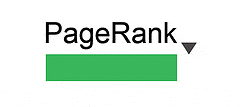Google Page Rank Is No More! Which Metric Is Next In Google’s Vision?
One of the most important ranking factors has been Google Page Rank, a number assigned to each Web page as per its robustness in terms of quality as well as the number of incoming links. It is a link analysis algorithm that rates a page on a scale of 0-10, of which 10 means the highest rank. Usually, Google shows this number in its browser toolbar after which several SEO tools began utilizing it as a relevant measure to assess the Google Juice of a page.
What happened after the advent of PageRank?
The increasing importance of Google page rank triggered almost an obsession amongst a majority of Webmasters and SEO experts. This resulted in black practices such as selling links and demanding more money for getting links from a blog or site having a higher Page Rank (PR). Obviously, this is something that Google never supports. Further, because of time gap between the two updates, there is also a mismatch between the Google generated and the publicly available PR.
The final outcome…
 Traditionally, Google updated the much-heralded page rank algorithm approximately after every three months. However, since the beginning of 2013, there has been no update. While PR is one of the more reliable metrics for evaluating the site’s quality when in service, it now seems to have taken a permanent retreat.
Traditionally, Google updated the much-heralded page rank algorithm approximately after every three months. However, since the beginning of 2013, there has been no update. While PR is one of the more reliable metrics for evaluating the site’s quality when in service, it now seems to have taken a permanent retreat.
Since 2009, the support for PR has been dropped, starting with the withdrawal from the Webmaster Tools. Google has never introduced its own toolbar or add-on for Chrome to show PR values. In 2011, it took back the support from Firefox; while Internet Explorer was the last browser to continue with the Google’s PR display.
The PR update happened in December 2012 but was not completely intentional. According to Google, the team was fixing a back-end service along with which a PR update occurred. The data flowing into the toolbar has not seen any update even in 2013.
The absence of any update in 2013 made many experts to believe that there might be some problem in the algorithm. Well, there was no problem with the algorithm. To this, the search spam head of Google Matt Cutts said, “The ‘pipeline’ to send rank updates to the toolbar is broken,” which indicates that the PR in the bar will not update automatically.”
He further explained that the team knew about the ‘no update’ decision in the Google Toolbar and that there is a good reason behind it. According to Google, several people obsess over this metric even though it is not a vital one anymore, due to which it is not a priority to fix it. This indicates that the PageRank meter, formerly designed to assist the visitors judge the quality of a Web page, now has data that is obsolete. Recently, Google’s John Mueller conveyed in a Google+ hangout video that Google would perhaps not update the Google Toolbar Page Rank anytime in future.
But Google might not remove forever
Yes! You heard it right. In early 2013, Google asserted that PR in the toolbar would not be going away as long as the users continue to use it. Cutts clarified that the consumers still consider PR as a useful metric. This is perhaps because anyone still having the toolbar obviously sends back the data to Google about what they are viewing, which persuades Google to retain the value for that particular page for further assessment. This means the last saved page rank values, although not latest because they are not updated, will be still in use by Google for allotting the position of Web pages on the search result pages.
Stop being obsessed about PR because…
Seriously speaking, PR is just a temporary influencer in fulfilling the objectives such as attract more readers, make more money, and have more leads. Considering PR as a success metric works only if one assumes that a higher PR is essential for better ranking, driving more traffic, and having more leads. Only those who believe this would consider giving importance to the page rank metric. However, Google does not believe in this assumption, which is evident in its ‘no update’ approach since more than two years.
One must remember that although the page rank is not updated, the SEO value of sites engaged in black or spammy practices are bound to go down; all thanks to the regular Penguin updates. So, why give importance to a page rank value when you can directly measure with the latest metrics that Penguin focuses on?
Still not convinced? Here are top 5 reasons why PR should not be a focal metric:
- Discrepancy between the displayed and generated rank
- No correlation with organic SEO ranking, as sites with 0 PR has considerable traffic for competitive search terms
- Irrelevant for social media results and real time search, for example, real time news and status updates having a PR 0 are shown up quickly in the search results
- Not a result-inclined metric because PR is not associated with any real results or with stuff that links directly to other Google-liked metrics
- Held insignificant by Google
So, What’s next in the metric list
Well, right now, it is hard to say what Google shall give importance to in its metric list. However, it is easy for a Webmaster to find the metrics directly related to meaningful gains or business goals for the site instead of just focusing on the page rank, says Susan Moskwa who is Webmaster Trends Analyst.
Moreover, it is worth considering metrics that are updated at fixed intervals instead of only a few times a year, as the latter is too gradual to know about the changes reliably. Susan suggests focusing on conversion rate, bounce rate, and clickthrough rate (CTR) through services such as Webmaster Tools or Google Analytics, which are the more critical metrics than page rank.
So, don’t you think it is time to leave behind the page rank metric?

